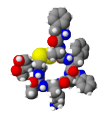|
 Researchers scanned the surface of liver cysts with an electron microscope. The surface contained: hormone receptors, insulin growth hormone receptors and growth hormone receptors. Researchers scanned the surface of liver cysts with an electron microscope. The surface contained: hormone receptors, insulin growth hormone receptors and growth hormone receptors.
Octreotide inhibits all of the liver cell surface: growth hormone inhibits insulin growth hormone and inhibits estrogen like hormones. 
|
Choose an article from the pulldown menu above. The first article discusses liver cysts arise only from cholangiocyte cells. This article goes on to explain many reasons to avoid hormones, false hormones, and endocrine disruptors, especially with PLD. To read more about xenoestrogens click here. For a printable list of false estrogens, click here.
The second article from the pull down menu is about the release of histamine can stimulate cholangiocyte proliferation. This could be a reason to attempt to avoid any of the most common allergic foods. The top ten allergic foods are: soy, peanuts, milk, eggs, tree nuts, fish, wheat, shellfish.
Polycystic Liver Disease PLD Liver cysts can arise only from cholangiocytes cells. These cholangiocytes make up only 3% of the totality of all our liver cells. Cholangiocytes are the only cells that are capable of becoming liver cysts. Yet they make up only 3% of all liver cells. Just amazing that 3% of our liver cells can produce so many symptoms from severe PLD polycystic liver disease. Cholangiocytes produce 40% of all bile.
Liver tissue is composed of either hepatocytes or cholangiocytes. Hepatocytes however make up 80-90% of total liver tissue. These developed liver cysts have both hormone receptors and somatostatin receptors on their exterior cellular surface. Within the interior of liver cysts there is something known as cyclic AMP or cAMP. Cyclic AMP is extremely elevated within liver cysts. From PKD research conducted by Dr. Grantham and later by Dr. Torres, we know that caffeine will elevate cyclic AMP. It is for this reason that many of us try to eliminate cAMP stimulants such as chocolate, coffee, de-caf and other caffeinated beverages, herbs, and foods. Exciting results were published by the Mayo Clinic in the Gastro Enterology Journal with PKD animal studies. Octreotide diminished liver cysts. Researchers are hopeful this will also prove useful for individuals with Caroli's Disease and ARPKD.
Animal studies with Octreotide dramatically decreased both liver and kidney cyst growth. Octreotide is a somatostatin analogue. It stimulates somatostatin receptors on the exterior of liver cysts. By increasing somatostatin Octreotide receptors, this decreases cyclic AMP within the cyst .
Decreasing cyclic AMP diminishes cyst growth, stops the oozing of fluid within cyst cells and in humans has resulted in a slowing of kidney cysts. In animal studies it has been shown to decrease liver cysts.
According to the article in Gastro Enterology, within liver cholangiocytes and within the serum of polycystic rats, their cysts contained approximately two (2) times higher concentrations of cAMP than in the normal non-cystic rats.
Tolvaptan, another not yet released experimental drug, blocks vasopressin. The vasopressin receptor site is located on the exterior of kidney cysts. Tolvaptan's blocking of vasopressin results in a decrease of cyclic AMP. Elevated Cyclic AMP plays a major role in cyst development and cyst proliferation. However tolvaptan has no effect on liver cysts whereas Octreotide diminishes both kidney and liver cysts. |
![]() contact
us
contact
us